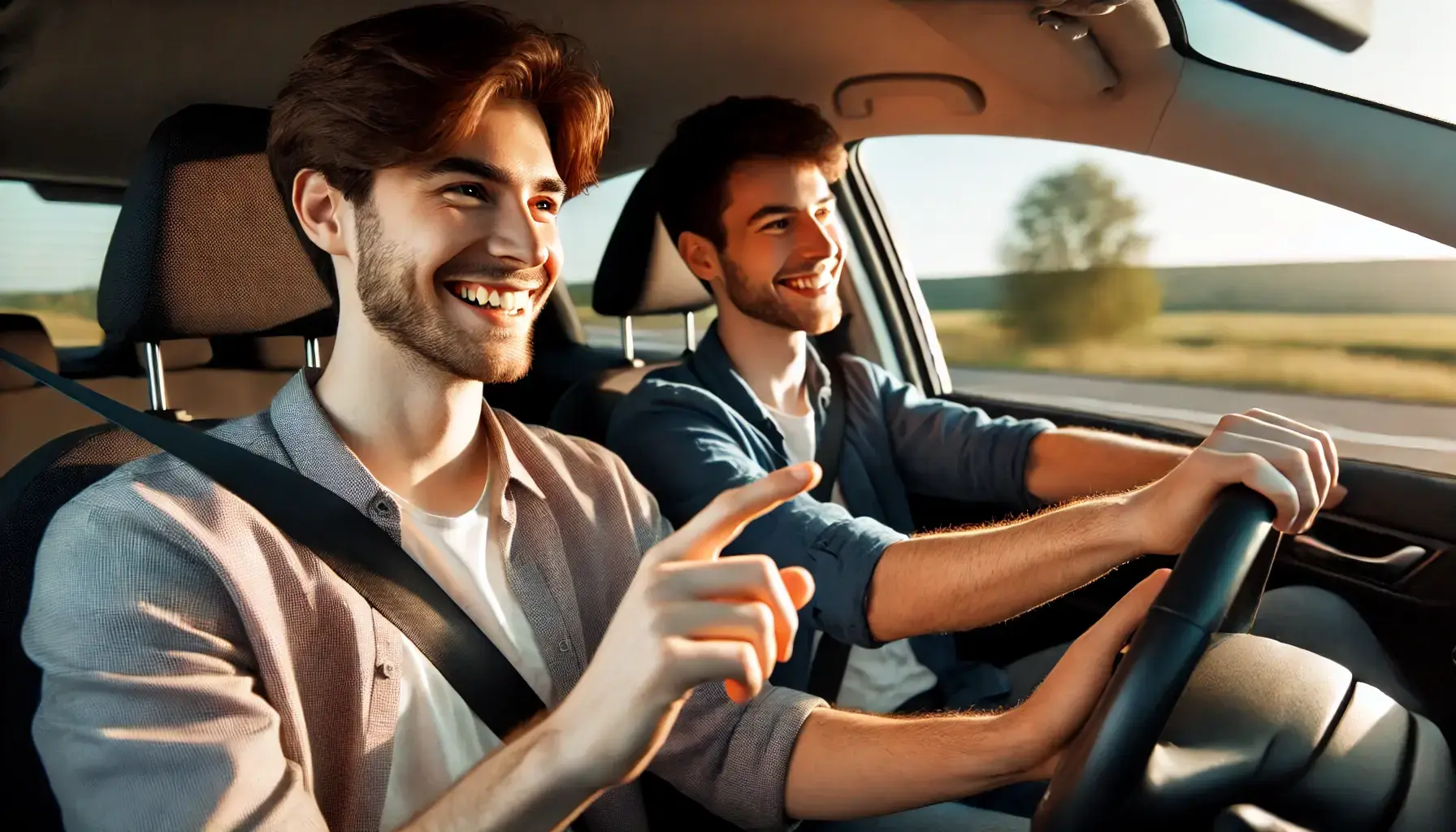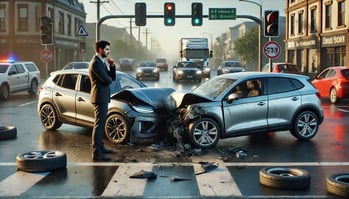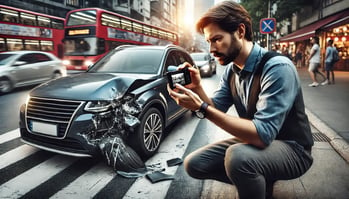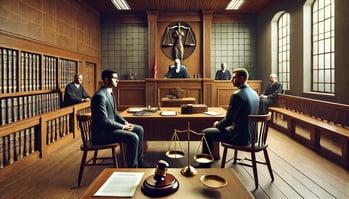What Happens If Someone Else is Driving My Car and Gets in an Accident?

Legally reviewed by:
Daniel Smith July 17, 2024
It’s the weekend, and your friend asks for your car to use for their date and gets into an accident while they are driving your vehicle. The other driver was also injured, and both cars sustained significant damage. What do you do in such a situation? Who is liable to pay for the damages to your vehicle, the other car, and the injuries sustained by the other?
In this article, we will uncover the complexities involved in car accidents when someone else is behind the wheel of the car you own, along with providing clarity on the liabilities and legal remedies and what you should do as the owner of the vehicle if you find yourself in such a situation. Whether you lent your car to a family member or a friend or if an unauthorized individual took your vehicle without permission and landed in an accident.
Who is Liable if Someone Else Crashes Your Car?
To determine the liability when someone else is driving a car registered in your ownership, it is crucial to understand various factors, including but not limited to the terms and conditions of your insurance policy and the capacity of the driver’s use.
In most cases, the car insurance is attached to the car and not the owner or driver of that vehicle. Hence, the insurance will most likely cover all damages related to the car damage in an accident. However, even though most insurance companies will cover the damages even if your family member or friend was driving your car, there are some nuances and exceptions to this situation.
Permissive and Non-Permissive Use
The first nuance is permissive and non-permissive use. Permissive use is when the car's owner clearly and explicitly permits the other to drive their vehicle. In this case, most insurance companies cover the damages, subject to their policies. However, some insurance companies have an additional limitation: They provide reduced damage coverage for drivers whose names were not listed on the insurance policy.
For instance, as per California Vehicle Code § 16056, it is required for drivers and the original vehicle owner to maintain liability insurance with a minimum coverage of fifteen thousand dollars ($15,000) for physical injury of one person, double for two or more people, and at least five thousand dollars ($5000) for collateral property damage, such as damage caused to the other car involved in the accident or nearby property damaged as a result of the accident.
Additionally, even permissive use coverage has its exceptions. For instance, permissive use only provides coverage for business-related car use if it is explicitly allowed in your insurance policy. If this specific provision is not present, the owner or the car's driver will be held liable if your vehicle crashes on a business trip. Also, permissive use is not applicable when the driver is unlicensed or a minor, which is known as negligent entrustment. This also applies even if you were not aware that an unlicensed or minor had borrowed your car, excluding in cases of theft.
On the other hand, non-permissive use, as the name suggests, occurs when the driver has not obtained explicit consent from the owner to drive the car. Some courts have ruled that insurance companies cannot be held liable for covering damages caused by an accident in which the driver did not have explicit permission from the car's owner.
In such circumstances, insurance coverage for damages might be denied, and the driver will be held personally liable for the damages. Furthermore, in case of theft that results in an accident with the thief or any other third party behind the wheel, depending on the terms and conditions of the relevant insurance policy and the state laws, the vehicle's owners may not be held liable.
Does It Matter If the Driver Has Their Own Policy?
The insurance policy may provide secondary coverage if the person driving your car has their own transportation or vehicle insurance policy. Hence, if the owner’s insurance policy or its limitation is exhausted covering the primary damages, the driver’s insurance policy may cover the additional secondary damages. This concept is also known as secondary or excess insurance.
However, some insurance policies may not cover any damages if your driving has resulted in an accident with a car not under your ownership. An insurance policy is generally attached to a vehicle and not the driver. Hence, it is pertinent to thoroughly read through the terms and conditions of your insurance policy and the driver’s auto insurance policy before lending your car significantly for an extended period.
What if Your Insurance Refuses to Pay?
Refrain from fretting if your insurance policy refuses for the damages resulting from an accident caused by someone else driving your car. The first thing on your agenda should be to calm down, collect yourself, and thoroughly peruse your auto insurance policy. Learn where you stand and ensure whether the refusal by the insurance company is justified.
If you believe your insurance claim was denied for unjustified reasons, your next step would be to appeal that refusal. Ensure that you provide all possible evidence, including but not limited to highlighted insurance policy provisions in your favor, proof of permissive use, and witness statements to strengthen your argument.
For example, screenshots of emails or text messages of you giving explicit permission to drive your car. If an appeal decision does not result in your favor, you can consider other legal remedies, such as using the court of law to remedy the infringement of your rights.
In cases where an unlisted driver has damaged your car in an accident, the insurance company may deny your claim for various reasons, such as exceptions listed in the policy, non-permissive use, or failure to promptly and appropriately report the accident.
For instance, if your auto insurance policy consists of a provision that clearly and explicitly denies primary or secondary coverage for drivers not listed on the said policy, there is a high chance that the insurance company will deny your claim.
How Do You Prove You Gave Permission for Someone Else to Drive Your Car
As mentioned above, you can use copies of your emails and text messages; providing explicit consent to drive your car is good enough evidence. For example, if there were any texts from the driver asking to borrow your car for a drive, and you agreed to it, it is valid evidence.
With a written consent agreement, proving permissive use of your vehicle can be more accessible. In such cases, witness testimonies can come in handy from persons present when you permitted the driver to use your car.
However, in some cases, past behaviour patterns can help support your claim of permissive use. For instance, if your sibling, child, friend, etc., has consistently borrowed your car with your permission, that can help support your claim for permissive use. Gathering evidence is critical in such situations. Evidence not only helps support your insurance claim but can also prove handling in case of legal proceedings.
Steps to Follow if Someone Else Crashes Your Car
Knowing what to do is half the battle. If your car is crashed by someone else, the below steps will help you resolve any issues.
Make Sure Everyone Is Safe
Sure, car accidents come with substantial financial costs. Still, the first step should be to ensure no life is lost and that if anyone needs urgent medical attention, safety should be everyone’s top priority. If you discover another driver has crashed your vehicle, ensure they’ve taken appropriate steps to protect their and other involved parties’ physical health.
Exchange Key Information
Once everyone is safe, the driver must exchange critical information with the other driver involved in the accident. In this case, essential information includes the driver’s full legal name, contact information, insurance details, and license plate numbers. This critical information is pertinent for filing insurance claims and will help with legal proceedings. An experienced car accident attorney can help you understand what information you should obtain after someone else crashes your car.
Document Everything
You need to document every angle of the after-effects of the accident. Take photos of the license plates of each car, the damage, and visible injuries, and any collateral damage. This documentation is essential for your insurance claim and potential legal proceedings. Photographic images prove to be very promising and admissible evidence, especially when establishing fault in an accident. Consider sketching a scene of the accident and how the accident occurred.
What to Do if the Accident Results in a Lawsuit
Knowing how to respond if an accident involving your car results in a lawsuit is very important. This can help you better protect your rights and lower financial liabilities. The following are the steps you should take when facing such a lawsuit.
Notify Your Insurance Company
Immediately inform your insurance company if you are facing a lawsuit. They owe you the duty to defend you under the liability coverage of your insurance policy. If another party's insurance company contacts you, avoiding saying anything that could damage your claim is essential. Leaving discussions with your attorney at the insurance company is the best idea.
Collect Evidence
Gather all the relevant evidence and documents you collected during the accident, including witness statements, police reports, and records of any communication with the driver that depicts permissive use. Such information shall prove beneficial for your defense. Rely on your attorney to determine what evidence will help in court.
Seek Legal Help
Hire a car accident lawyer who can help you prepare and submit timely responses to court notices and documents. Delaying your responses can lead to a default judgment, which means a decision will be made without the court hearing your side of the story, which can often be unfavorable.
The outcome of your lawsuit depends on the strength of your case, which heavily relies on the quality of your evidence. The potential consequences include settlement (parties deciding to settle out of court for a mutually agreed amount paid to the aggrieved party), the trial verdict (the case goes to trial, and the jury provides a verdict based on evidence), and appeal (often the judgment debtor or losing party may appeal the court’s decision).
At The Accident Helpers, we connect people who have been injured and need legal representation to a network of car accident and personal injury attorneys nationwide so victims can get the compensation they deserve.
What if Your Kid Borrows Your Car?
Proving liability and succeeding in an insurance claim becomes slightly tricky when your child drives your vehicle, especially if the child is a minor. Most insurance policies provide coverage for family members living in the same household. However, if the child is a minor, you, as the parent, can be held vicariously liable for their actions subject to the relevant state laws.
For instance, per California Vehicle Code (CVC) Section 17707, a minor's parent or legal guardian can be held liable for any damages and injuries caused by the child while driving. Texas and Delaware also follow California on the parent liability doctrine.
Therefore, you must list your children on the insurance policy as drivers if they drive a car registered under your name. If you fail to do this, then seeking insurance coverage may be hard to get in case you get in an accident while driving your car. Furthermore, it is also essential to teach your children the driving responsibilities so they prevent themselves from getting hurt and don’t cause irreparable damage to the other party. This includes emphasizing the importance of avoiding distractions, following traffic laws, and driving defensively.
This also means anticipating various hazards and driving accordingly to prevent the risk of accidents and collisions. For instance, when you try to merge on a busy highway, if you are driving defensively, you will ensure that your car is in an excellent situation to make the merge. This can be done by adjusting your seat belts, checking the mirrors for the vehicles behind, planning your route, and making sure you are aware of the exit and entry points of the highway.
Different Types of Auto Insurance Coverage
Understanding the different types of auto insurance coverage is essential, especially when you often allow others to drive your car. The following are various types of auto insurance coverage available in the US and their implications.
Collision Insurance
This auto insurance coverage pays to replace or repair your car after a collision, regardless of who is at fault. It is also known as “No-Fault Insurance” in states like Michigan.
Liability Insurance
This type of insurance covers the injuries and damages caused to others due to the accident. Most states consider Liability insurance mandatory; however, the minimum coverage limits vary. For instance, California Vehicle Code § 16056, as stated above, provides a minimum coverage of $5000 for property damage, $30,000 for death or injury of two or more persons, and $15,000 for death or injury of one person due to the accident.
Comprehensive Insurance
This type of auto insurance covers damage to your car caused by non-collision events such as vandalism, theft, or natural disasters. Having a comprehensive insurance policy can protect you from a variety of dilemmas that you may not foresee. It’s better to have the protection in place than to be left scrambling after an unforeseen accident occurs.
Underinsured or Uninsured Motorist Coverage
This type of insurance provides coverage when the person driving your car does not have sufficient insurance to cover your damages or any other secondary damages. This type of insurance is also valuable when an uninsured driver hits your vehicle.
MedPay Insurance
MedPay insurance, or medical payments coverage, helps pay for any medical support required due to the accident. MedPay is also effective when someone else is driving your car, as it is not only a no-fault insurance attached to the insured vehicle but also to the car's owner.
Personal Injury Protection (PIP)
This type of insurance is also no-fault, covers medical expenses, and may also cover damages and lost wages. In states like Michigan and Florida, personal injury protection is mandatory.
The Accident Helpers are Here to Help
Understanding the complexities of insurance coverage and legal liability can be daunting. However, being proactive, educated, and informed can protect yourself, your loved ones, and your assets in such traumatic scenarios.
The Accident Helpers can provide valuable information in such scenarios by connecting you to expert advice and support to ensure you handle the consequences of an accident accurately and effectively. Whether you have to deal with insurance companies, gather evidence, or seek legal remedies in such a situation.




